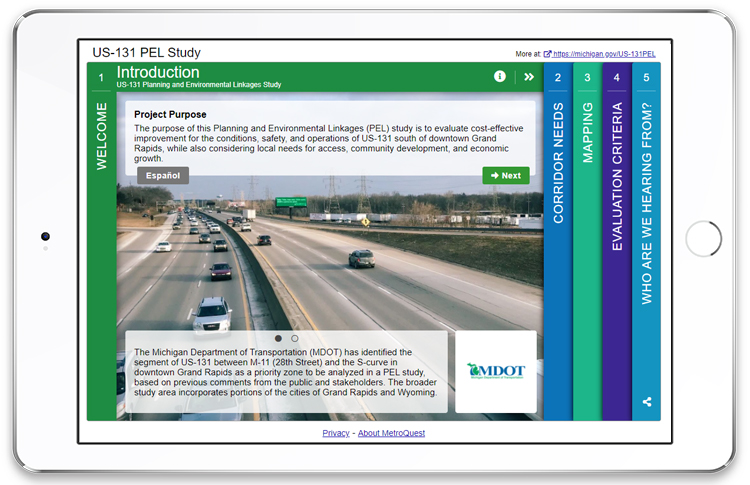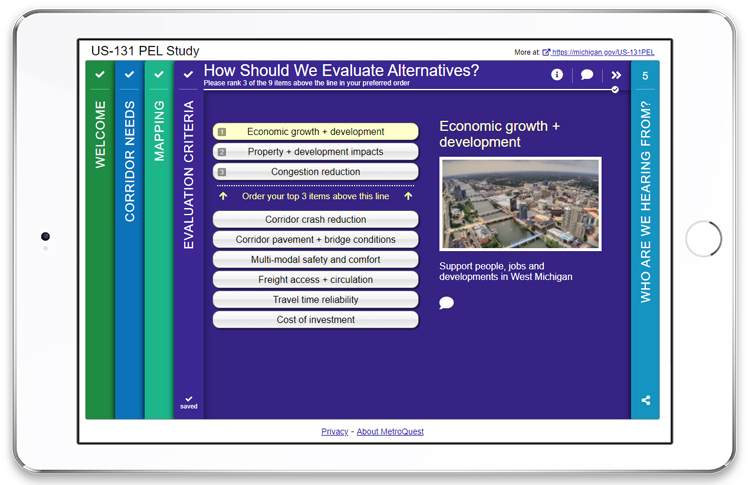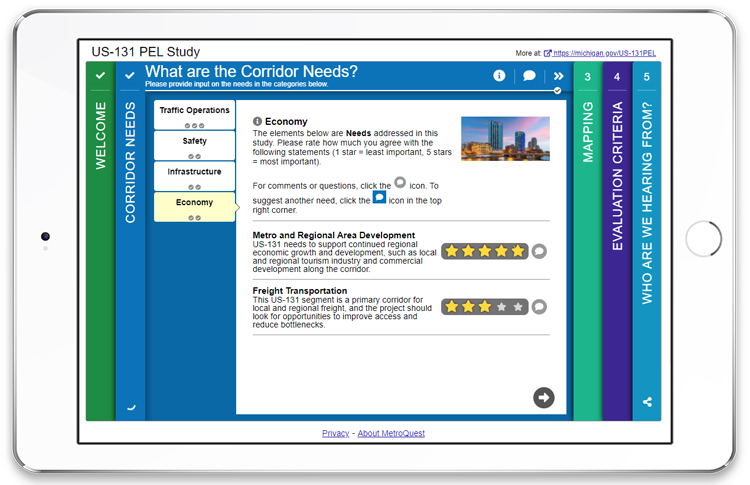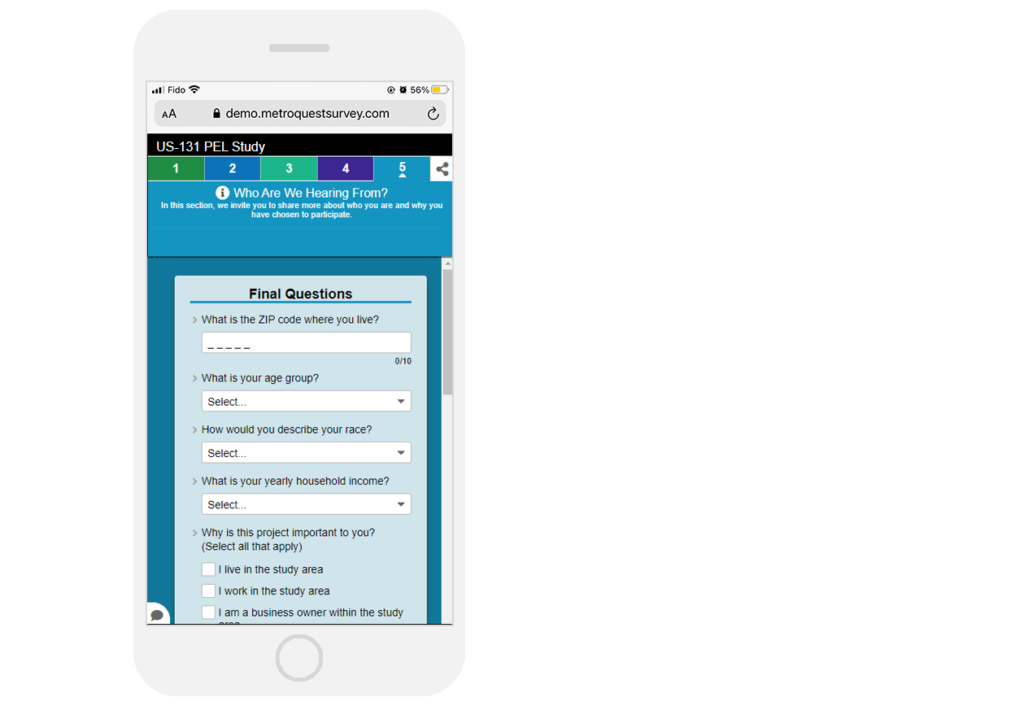[SURVEY OF THE MONTH] Evaluating Corridor Improvements with Michigan DOT and AECOM
![[SURVEY OF THE MONTH] Evaluating Corridor Improvements with Michigan DOT and AECOM [SURVEY OF THE MONTH] Evaluating Corridor Improvements with Michigan DOT and AECOM](https://metroquest.com/wp-content/uploads/SURVEY-OF-THE-MONTH-Evaluating-Corridor-Improvements-with-Michigan-DOT-and-AECOM-1.png)
The Survey of the Month series is a monthly blog where we highlight the extraordinary work our customers are doing, along with some takeaways that are relevant for anyone interested in making the most out of online engagement using MetroQuest’s online survey platform!
This month, we are excited to highlight some recent work from the Michigan Department of Transportation (MDOT) and AECOM, a long-standing customer that has created countless fantastic surveys for a wide-ranging variety of projects. We will be focusing on their work on our new platform, MetroQuest 2020. To read about the latest releases, check out our blogs. If you are unsure which version you and your team are on, please contact us to ensure you can benefit from updates and new feature releases!
What’s the story? US-131 Planning and Environmental Linkages Study
AECOM is working with the Michigan Department of Transportation (MDOT) on a Planning and Environmental Linkages (PEL) study. PELs are decision-making approaches that focus on environmental aspects, the community, as well as economic goals in the early phases of a transportation planning process. The outcome of a PEL informs the formal federal National Environmental Policy Act (NEPA) environmental review process.
Based on previous public and stakeholder feedback, MDOT identified a segment of US-131 in the area around the cities of Grand Rapids and Wyoming as a priority zone to be analyzed in a PEL study. The purpose of the study was to evaluate improvements for the corridor respective to conditions, safety, and operations, as well as local access needs, community development, and economic growth. The first phase of public involvement of the US-131 PEL wrapped up in February of this year. We’ll take a closer look at the survey that the team used to gather public opinion.
For more information on the project, please visit the official webpage: https://michigan.gov/US-131PEL.
Anatomy of a PEL Survey: Using MetroQuest to Identify Corridor Needs, Issues, and Solutions
After a short introduction on the Welcome Screen, the interactive part of the survey starts with a Strategy Rating Screen. Here, participants were asked about corridor needs in different categories, including traffic operations, safety, infrastructure, and economy. Participants were presented with statements regarding needs addressed in the study and were asked to provide their agreement through means of selecting their response on a five-point scale.
On the next Screen, participants were asked to identify issues geospatially on a Map by means of placing markers. The markers allowed participants to indicate areas of safety, congestion, multi-modal opportunities, pavement/ramp/bridge conditions, and “other”. Each marker allowed participants to type in a response to explain their choice or describe the issue. A great feature utilized on this Map Marker Screen is the location drop down – see further down for details on how this was used!
Finally, before answering demographic questions, participants were presented with a Priority Ranking Screen where they were asked to rank evaluation criteria for different elements of potential solutions. The criteria to rank were, in random order: Property + development impacts, Travel time reliability, Congestion reduction, Multi-modal safety and comfort, Corridor crash reduction, Freight access + circulation, Cost of investment, Economic growth + development, and Corridor pavement + bridge conditions. By gathering data about broad public opinion around potential solutions, planners can understand what priorities are important to the public and stakeholders.
If you’d like to try the survey, try this demo survey. This version does not collect data and will not affect the survey results.
5 Tips from US-131 PEL Study: Incentivize Input by Presenting Complex Materials in a Straightforward Way
AECOM’s wealth of experience with MetroQuest shines through in this well-executed survey. Here are 5 takeaways from their survey to make your next survey a success as well:
- We really liked how this survey explains the purpose of the survey briefly and concisely, right up front on the Welcome Screen that visitors see when they first arrive. Within seconds, visitors can get context for the project, which helps them feel invested and prompts them to continue taking the survey.
- We typically recommend progressing your Screens by starting with simple tasks and moving on to more complex one. In other words, we always suggest starting your survey with the easiest type of Screen to complete. This is in part to warm up participants to how they will be providing input and also to give them a sense of how fun and quick this survey will be.
- At the same time, you also want to ensure that you are asking what is most important early in the experience when you have participants’ fullest attention. The Strategy Rating Screen used in this example can be text heavy and complicated, but AECOM brilliantly avoided that by asking for input on only 2-3 needs in 4 categories. This makes the Screen feel more manageable and avoids overwhelming the participant with too much text but is also able to gather the data that the survey team really wants right at the beginning of the survey. This might sound counter-intuitive, but less text means you will receive more input, or, more specifically, fewer items yield more data. Bottom line: Ask only what you really want to know!
- A great feature that this survey utilized on the Map Marker Screen is the location drop down. This allows participants to zoom into an area of interest to provide input. It also gives you more accurate data!
- Speaking of dropdowns, AECOM wisely chose to use mostly dropdown or checkbox answers on the final Wrap Up Screen for demographic questions. This allows participants to provide their information much faster than typing which means they are more likely to do so. Also – have you ever wondered why we recommend our customers to ask for demographic information at the very end? Our experience has taught us that participants are more likely to tell you about themselves after they have already provided input on the project and have a vested interest!
With clever use of MetroQuest Screens and a great understanding of what makes an excellent survey, AECOM and MDOT put their best food forward for this PEL study. With promotions on media and social media, they got a high response with over 2000 survey responses. Congratulations to the team for a fantastic survey!
For more great tips on how to make the most out of MetroQuest, contact your Customer Experience manager or reach out for more information. The latest version of MetroQuest includes many new and highly anticipated updates and features. If you are not yet on the new platform, please contact me to get you set up!



